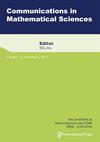在 $\mathbb{R}^3$ 中具有无限质量和速度的引力弗拉索夫-泊松系统
IF 1.3
4区 数学
Q2 MATHEMATICS, APPLIED
引用次数: 0
摘要
我们研究在 $\mathbb{R}^3$ 中演化的引力弗拉索夫-泊松系统解的存在性和唯一性。假设粒子最初是按照空间密度分布的,空间密度具有幂律衰减,允许质量无约束,速度的指数衰减由麦克斯韦-玻尔兹曼定律给出。我们扩展了一个经典结果,该结果适用于总质量有限的系统。本文章由计算机程序翻译,如有差异,请以英文原文为准。
The gravitational Vlasov-Poisson system with infinite mass and velocities in $\mathbb{R}^3$
We study existence and uniqueness of the solution to the gravitational Vlasov–Poisson system evolving in $\mathbb{R}^3$. It is assumed that initially the particles are distributed according to a spatial density with a power-law decay in space, allowing for unbounded mass, and an exponential decay in velocities given by a Maxwell–Boltzmann law. We extend a classical result which holds for systems with finite total mass.
求助全文
通过发布文献求助,成功后即可免费获取论文全文。
去求助
来源期刊
CiteScore
1.70
自引率
10.00%
发文量
59
审稿时长
6 months
期刊介绍:
Covers modern applied mathematics in the fields of modeling, applied and stochastic analyses and numerical computations—on problems that arise in physical, biological, engineering, and financial applications. The journal publishes high-quality, original research articles, reviews, and expository papers.

 求助内容:
求助内容: 应助结果提醒方式:
应助结果提醒方式:


